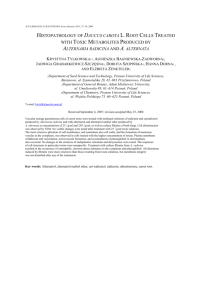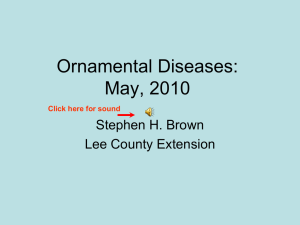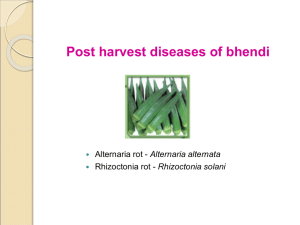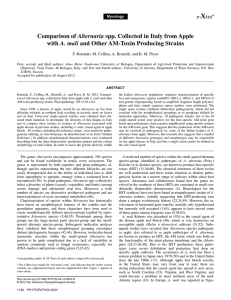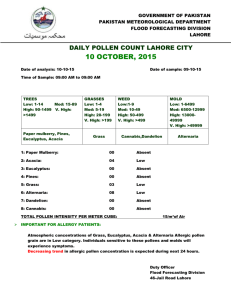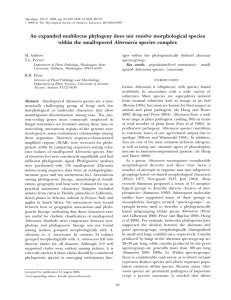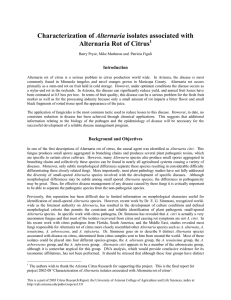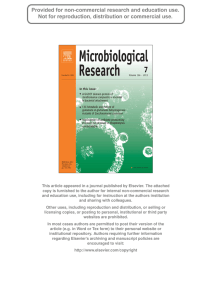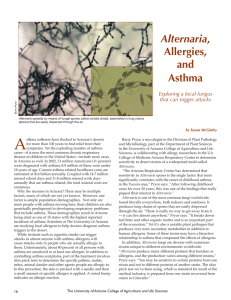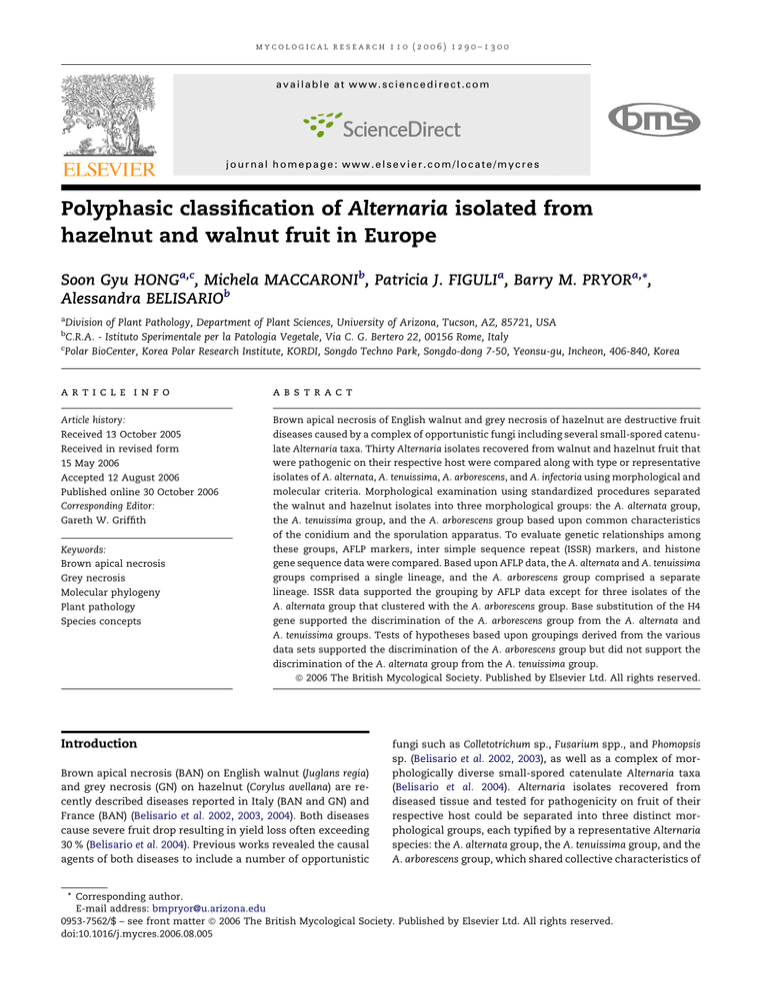
mycological research 110 (2006) 1290–1300
available at www.sciencedirect.com
journal homepage: www.elsevier.com/locate/mycres
Polyphasic classification of Alternaria isolated from
hazelnut and walnut fruit in Europe
Soon Gyu HONGa,c, Michela MACCARONIb, Patricia J. FIGULIa, Barry M. PRYORa,*,
Alessandra BELISARIOb
a
Division of Plant Pathology, Department of Plant Sciences, University of Arizona, Tucson, AZ, 85721, USA
C.R.A. - Istituto Sperimentale per la Patologia Vegetale, Via C. G. Bertero 22, 00156 Rome, Italy
c
Polar BioCenter, Korea Polar Research Institute, KORDI, Songdo Techno Park, Songdo-dong 7-50, Yeonsu-gu, Incheon, 406-840, Korea
b
article info
abstract
Article history:
Brown apical necrosis of English walnut and grey necrosis of hazelnut are destructive fruit
Received 13 October 2005
diseases caused by a complex of opportunistic fungi including several small-spored catenu-
Received in revised form
late Alternaria taxa. Thirty Alternaria isolates recovered from walnut and hazelnut fruit that
15 May 2006
were pathogenic on their respective host were compared along with type or representative
Accepted 12 August 2006
isolates of A. alternata, A. tenuissima, A. arborescens, and A. infectoria using morphological and
Published online 30 October 2006
molecular criteria. Morphological examination using standardized procedures separated
Corresponding Editor:
the walnut and hazelnut isolates into three morphological groups: the A. alternata group,
Gareth W. Griffith
the A. tenuissima group, and the A. arborescens group based upon common characteristics
of the conidium and the sporulation apparatus. To evaluate genetic relationships among
Keywords:
these groups, AFLP markers, inter simple sequence repeat (ISSR) markers, and histone
Brown apical necrosis
gene sequence data were compared. Based upon AFLP data, the A. alternata and A. tenuissima
Grey necrosis
groups comprised a single lineage, and the A. arborescens group comprised a separate
Molecular phylogeny
lineage. ISSR data supported the grouping by AFLP data except for three isolates of the
Plant pathology
A. alternata group that clustered with the A. arborescens group. Base substitution of the H4
Species concepts
gene supported the discrimination of the A. arborescens group from the A. alternata and
A. tenuissima groups. Tests of hypotheses based upon groupings derived from the various
data sets supported the discrimination of the A. arborescens group but did not support the
discrimination of the A. alternata group from the A. tenuissima group.
ª 2006 The British Mycological Society. Published by Elsevier Ltd. All rights reserved.
Introduction
Brown apical necrosis (BAN) on English walnut (Juglans regia)
and grey necrosis (GN) on hazelnut (Corylus avellana) are recently described diseases reported in Italy (BAN and GN) and
France (BAN) (Belisario et al. 2002, 2003, 2004). Both diseases
cause severe fruit drop resulting in yield loss often exceeding
30 % (Belisario et al. 2004). Previous works revealed the causal
agents of both diseases to include a number of opportunistic
fungi such as Colletotrichum sp., Fusarium spp., and Phomopsis
sp. (Belisario et al. 2002, 2003), as well as a complex of morphologically diverse small-spored catenulate Alternaria taxa
(Belisario et al. 2004). Alternaria isolates recovered from
diseased tissue and tested for pathogenicity on fruit of their
respective host could be separated into three distinct morphological groups, each typified by a representative Alternaria
species: the A. alternata group, the A. tenuissima group, and the
A. arborescens group, which shared collective characteristics of
* Corresponding author.
E-mail address: bmpryor@u.arizona.edu
0953-7562/$ – see front matter ª 2006 The British Mycological Society. Published by Elsevier Ltd. All rights reserved.
doi:10.1016/j.mycres.2006.08.005
Alternaria from hazelnut and walnut
the conidium and three-dimensional sporulation apparatus
(Belisario et al. 2004). Interestingly, this morphological
diversity appeared to be fully represented across hosts, with
no significant differences in pathogenicity or symptom
development among isolates within each host-defined group
(Belisario et al. 2004).
The finding of a morphologically diverse complex of smallspored catenulate Alternaria taxa recoverable from a single
host is not unusual. Similar complexes have been recovered
from a number of additional hosts including citrus (Simmons
1990), pear (Simmons & Roberts 1993), cherry (Roberts et al.
2000), almond (Teviotdale et al. 2001), pistachio (Pryor &
Michailides 2002), apple (Serdani et al. 2002), and barley
(Andersen et al. 2002). Perhaps the most comprehensively
documented case was the work of Simmons & Roberts, which
involved taxa recovered from necrotic lesions on pear and
were considered putative causal agents of black spot of pear
(Simmons & Roberts 1993). In this study, six distinct morphological groups were recovered, notable groupings being the
A. gaisen group (most of which represented A. gaisen), the
A. alternata group, the A. infectoria group, and the arborescent
group [later typified by A. arborescens (Simmons 1999b)]. Further work revealed that pathogenicity on pear could be attributed to members of three of the six groups with no differences
in pathogenicity or symptom development noted among toxigenic isolates (Simmons & Roberts 1993). Results from studies
that included isolates from citrus, cherry, almond, pistachio,
apple, and barley were similar to those of the pear study in
that two to four distinct morphological groupings of taxa
were revealed per host, most typically including the A. alternata group, the A. tenuissima group, the A. arborescens group,
and/or the A. infectoria group. Importantly, pathogenicity
was always attributed to more than one morphological group.
Although it appears well documented that there exists
a number of morphologically distinct groups of small-spored
catenulate Alternaria recoverable as a complex from a number
of different hosts, the phylogenetic relationship among these
groups is less clear. Studies based upon sequence analysis
have revealed that small-spored catenulate Alternaria cluster
into three distinct monophyletic clades termed speciesgroups: the brassicicola species-group (uncommonly encountered), the infectoria species-group, and the alternata
species-group (Pryor & Gilbertson 2000; Pryor & Bigelow
2003). Note that the term ‘species-group’ has been adapted
from previous usage by Simmons (1992), and when preceded
by the non-italicized specific epithet of a representative taxon
has been adopted as the nomenclatural format for phylogenetically-based infrageneric groupings of Alternaria in general
(Pryor & Gilbertson 2000). This usage is to be differentiated
from the more specific application of the term ‘group’
(preceded by the Latin name of a representative taxon) often
used in discussions of morphologically similar small-spored
catenulate taxa as initiated by Simmons (1990). Members
of the A. infectoria (morphological) group all belong to the
infectoria species-group, which is genetically distinct and phylogenetically distant from other species-groups. However,
the other morphological groups discussed, the A. alternata,
A. tenuissima, A. gaisen, and A. arborescens groups, all are
encompassed within the alternata species-group, which reveals very close phylogenetic relatedness among these groups
1291
(Pryor & Gilbertson 2000; Pryor & Bigelow 2003). Moreover, sequence variation in loci most commonly used for phylogenetic
studies (e.g. ITS, mtSSU) has not been sufficient for robust discrimination among morphological groups within the alternata
species-group and has presented significant challenges for
systematic, diagnostic, and population studies (Kusaba &
Tsuge 1995; Chou & Wu 2002; de Hoog & Horre 2002; Pryor &
Michailides 2002; Pryor & Bigelow 2003; Serdani et al. 2002;
Kang et al. 2002; Konstantinova et al. 2002).
A number of studies have employed DNA fingerprinting for
analysis of relationships among morphologically distinct taxa
or groups within the alternata species-group. The most common techniques used for this purpose have been RAPD-PCR,
RFLP, and PCR-RFLP analysis (Kusaba & Tsuge 1994; Weir
et al. 1998; Roberts et al. 2000; Pryor & Michailides 2002; Peever
et al. 2002). However, results from these studies have not been
in agreement in regard to which morphological groups represent distinct phylogenetic lineages. RAPD analysis of isolates
recovered from pear and cherry, primarily, supported segregation of the A. alternata, A. tenuissima, A. arborescens, A. gaisen,
and A. infectoria groups based upon morphology (Roberts
et al. 2000). However, studies using RAPD and PCR-RFLP data
from groups recovered from pistachio only supported segregation of the A. arborescens and A. infectoria groups, but isolates
in the A. alternata and A. tenuissima groups resolved as a single
clade with no segregation of morphological types (Pryor &
Michailides 2002).
Other fingerprinting methods commonly used in studies of
populations or closely related taxa include AFLP and inter simple sequence repeat (ISSR) analyses. Since its development
(Vos et al. 1995), AFLP analysis has been applied to population
studies of diverse organisms including bacteria (Janssen et al.
1996, 1997), fungi (Mueller et al. 1996; Arenal et al. 1999; de Barros Lopes et al. 1999), plants (Travis et al. 1996), and animals
(Folkertsma et al. 1996). Along with the widespread application
across all phyla, AFLP analysis provides advantages over other
methods in its reproducibility (Janssen et al. 1996). ISSR analysis involves selective amplification of regions lying between
tandemly repeating arrays of short oligonucleotide sequences,
described as minisatellite or microsatellite sequences depending on their size (Hamada et al. 1982; Jeffreys et al. 1985). ISSR
analysis has been shown informative when comparing closely
related species or elements of the same species, which has
made it useful in a variety of genetic studies in plant, animal,
and fungal species (Liu & Wendel 2001; McCall et al. 2004;
Zhou et al. 2001). However, its use in resolving relationships
among morphological groups within Alternaria has not yet
been assessed.
For loci previously mentioned, sequence analysis has not
been a suitable method for reconstructing relationships
within the alternata species-group. However, several lesscommonly used loci appear to have potential. The endo-PG
gene has been shown to be informative for discrimination
among closely related Alternaria, and has been used successfully, along with sequences from anonymous regions, for
reconstructing relationships among small-spored taxa recovered from citrus (Peever et al. 2004, 2005). The histone 4 (H4)
gene region has also been shown to provide high resolution
in discriminating closely related species and sub-specific
groups among Fusarium and Colletotrichum spp. (Donaldson
1292
S. G. Hong et al.
et al. 1995; Talhinhas et al. 2002), although its usefulness in
Alternaria systematics has not been assessed.
The objectives of this work were to examine diversity
among small-spored catenulate species of Alternaria associated with fruit necrosis of walnut and hazelnut and compare
molecular-based groupings based upon AFLP, ISSR, and H4 sequence analysis with those based upon morphology. In addition, the robustness of these analyses was evaluated both as
single data sets and in concatenation, to establish methods
that should be given priority in subsequent studies of relationships among small-spore, catenulate Alternaria taxa.
Materials and methods
Fungal isolates and nucleic acid extraction
Thirty single-conidial isolates of small-spored catenulate
Alternaria taxa were isolated from symptomatic hazelnut
and English walnut fruit (Table 1). All isolates used in this
study were pre-screened for pathogenicity, and only isolates
that were pathogenic both on leaves and on fruit of the respective host were included (Belisario et al. 2004). All isolates were
cultured on weak potato dextrose agar (WPDA) (Pryor &
Michailides 2002) and incubated in a fully programmable
growth chamber (Conviron ATC 10-3, Conviron Controlled Environments, Pembina, ND) using the following environmental
parameters: temperature, constant at 22 C; humidity, constant at 25 % RH; lighting, 60 mmoles/m2/s using Sylvania
FB031/841/XP 31-watt fluorescent lamps (Osram Sylvania,
Danvers, MA) at a 10:14 light:dark cycle. Morphological characterization and grouping were based upon criteria established in a previous study (Pryor & Michailides 2002). Type or
representative cultures of A. alternata, A. tenuissima, A. arborescens, and A. infectoria (EGS 34-016, EGS 34-015, EGS 39-128, and
EGS 27-193, respectively) were included for comparative
purposes and as reference for each morphological group.
For DNA extraction, isolates were grown on potatoes dextrose agar (PDA; Difco, Detroit, MI) for one week at 22 C in
the dark. Total genomic DNA was extracted from 120 mg of
fresh mycelium powdered in 1.5 ml Eppendorf tubes with
a sterile pestle in liquid nitrogen. The remainder of the procedure for DNA extraction followed the protocol provided by
Puregene for Genomic DNA Purification Kit (Gentra Systems,
Minneapolis, MN). Total DNA was resuspended in 50 ml of
sterile TE buffer and stored at 20 C. DNA concentration
was estimated visually in 1 % agarose gels by comparing
band intensity with known quantities of l DNA markers
Table 1 – Isolates used in this study and their sources
Species or morphogroup
Code
Host
Origin/Source
Alternaria infectoria
A. alternata
A. tenuissima
A. arborescens
A. alternata group
A. alternata group
A. alternata group
A. alternata group
EGS 27-193 (Ex-type)
EGS 34-016 (Representative)
EGS 34-015 (Representative)
EGS 39-128 (Ex-type)
ISPaVe 1769
ISPaVe 1779
ISPaVe 1781
ISPaVe 1782
Triticum sp.
Arachis hypogaea
Dianthus sp.
Lycopersicon esculentum
Juglans regia
J. regia
J. regia
J. regia
A.
A.
A.
A.
A.
A.
A.
A.
A.
A.
A.
A.
A.
A.
A.
A.
A.
A.
A.
A.
A.
A.
A.
A.
A.
A.
ISPaVe
ISPaVe
ISPaVe
ISPaVe
ISPaVe
ISPaVe
ISPaVe
ISPaVe
ISPaVe
ISPaVe
ISPaVe
ISPaVe
ISPaVe
ISPaVe
ISPaVe
ISPaVe
ISPaVe
ISPaVe
ISPaVe
ISPaVe
ISPaVe
ISPaVe
ISPaVe
ISPaVe
ISPaVe
ISPaVe
Corylus avellana
J. regia
J. regia
J. regia
J. regia
J. regia
J. regia
J. regia
J. regia
J. regia
J. regia
C. avellana
C. avellana
C. avellana
C. avellana
C. avellana
C. avellana
J. regia
J. regia
J. regia
C. avellana
C. avellana
C. avellana
C. avellana
C. avellana
C. avellana
E. G. Simmons
E. G. Simmons
E. G. Simmons
E. G. Simmons
Treviso, Italy
Labretonie, France
Treviso, Italy
St Livrade
sur Lot, France
Viterbo, Italy
Ferrara, Italy
Treviso, Italy
Treviso, Italy
Rovigo, Italy
Rovigo, Italy
Treviso, Italy
Rovigo, Italy
Treviso, Italy
Jusix, France
Agen, France
Viterbo, Italy
Viterbo, Italy
Viterbo, Italy
Viterbo, Italy
Viterbo, Italy
Viterbo, Italy
Rovigo, Italy
Treviso, Italy
Labretonie, France
Viterbo, Italy
Viterbo, Italy
Viterbo, Italy
Viterbo, Italy
Viterbo, Italy
Viterbo, Italy
alternata group
arborescens group
arborescens group
arborescens group
arborescens group
arborescens group
arborescens group
arborescens group
arborescens group
arborescens group
arborescens group
arborescens group
arborescens group
arborescens group
arborescens group
arborescens group
arborescens group
tenuissima group
tenuissima group
tenuissima group
tenuissima group
tenuissima group
tenuissima group
tenuissima group
tenuissima group
tenuissima group
1796
1722
1768
1771
1772
1774
1775
1776
1778
1780
1784
1787
1791
1793
1794
1795
1797
1770
1773
1783
1786
1788
1789
1790
1792
1798
Date
2001
2001
2001
2001
2002
1998
2001
2001
2001
2001
2001
2001
2001
2001
2001
2001
2001
2001
2001
2002
2002
2001
2001
2001
2001
2001
2001
2001
2001
2002
Alternaria from hazelnut and walnut
(Amersham Biosciences, Piscataway, NJ). The stock DNA was
diluted to10 ng/ml and stored in TE buffer at 4 C to standardize concentrations for working DNA solutions.
AFLP analysis
AFLP DNA fingerprinting analysis was performed as described
by Vos et al. (1995) except that a fluorescence-labelled primer
was used instead of a radio-labelled primer. Template DNA
was prepared by digestion with the restriction enzymes, EcoRI
and MseI, and ligation with EcoRI-adapter and MseI-adapter.
Pre-selective PCR was performed using a thermal cycler
(PTC-100, Bio-Rad, Waltham, MA) with two primers for each
adapter, E-0 (GACTGCGTACCAATTC) and M-0 (GATGAGTCCT
GAGTAA). Selective PCR was performed using two set of
primers, E-AG/M-GA and E-AG/M-GT, where the code following E or M refers to additional selective nucleotides at the 30
end of the two non-selective primers, E-0 and M-0. E-AG
primer was labelled with 6-carboxyfluoescein (Sigma-Aldrich,
St. Louis, MO) at the 50 end. PCR products were analysed by
a Perkin-Elmer 3100 sequencing machine (Applied Biosystems, Foster City, CA) with the size marker, GeneScan-500
(ROX; Applied Biosystems).
Peak profiles were read with GenescanView software
(available at http://bmr.cribi.unipd.it/). Filtering and alignment of peaks were conducted in three steps. Initially, peaks
smaller than 5 % of highest peak were removed. Retained
peaks were aligned based upon DNA fragment size. Peaks
smaller than 10 % of the highest peak were removed unless
their peak heights were over 75 % of the corresponding peaks
from related isolates that were accepted. This three-step filtering and alignment method was used to reduce possible errors resulting from peak height variation among AFLP PCR
reactions. Peaks between 50 and 450 bp were scored and a binary matrix was constructed. Cluster analysis of the data matrix was performed by the UPGMA with Jaccard’s similarity
coefficient (Sneath & Sokal 1973) and the goodness of fit was
measured by cophenetic correlation (r) analysis using the software NTSYSpc ver. 2.1 (Exeter Software, Setauket, NY).
ISSR analysis
Among the eight primers tested, two minisatellite primers
(M13 and T3B, 50 - GAGGGTGGCGGTTCT-30 and 50 -AGG
TCGCGGGTTCGAATCC-30 , respectively) and two microsatellite primers [(GACA)4 and (CAA)5] were selected based upon
the production of distinct and reproducible banding patterns.
Amplification reactions were performed using a thermal
cycler (Gene Amp System 9700 Applied Biosystems, Foster
City, CA) in volumes of 25 ml containing 2 ml of working solution of template DNA (approximately 20 ng), 0.5 mM primer,
0.2 mM each dNTP, 2.5 mM MgCl2, and 1 unit of AmpliTaq
DNA polymerase in 1 AmpliTaq PCR buffer II (Applied Biosystems). The PCR was carried out in the following conditions:
94 C for 1 min, 50 C for 1.5 min, 72 C for 2 min for 40 cycles.
Ten microlitres of PCR products were resolved in 1 % agarose
gels in 0.5 % Tris–borate–EDTA (TBE) buffer and visualized by
UV illumination after staining in ethidium bromide. Gels
were photographed on a UV-transilluminator using a digital
1293
imaging system (Gel DOC, Bio-Rad, Hercules, CA) and bands
were scored as present or absent (1/0). ISSR analyses were performed three times to confirm reproducibility of amplification
products. The same clustering procedures and goodness of fit
measurements were conducted as for AFLP fingerprint analysis for PCR products between 200 and 2000 bp.
H4 PCR and sequencing
Amplification reactions were performed using the H4-1a/H41b primer pair (Glass & Donaldson 1995). PCR was performed
using a thermal cycler (Gene Amp System 9700 Applied Biosystems, Foster City, CA), and each 50-ml amplification reaction consisted of the following: 2 ml of working solution of
template DNA (approximately 20 ng), 0.3 mM primer, 0.2 mM
each dNTP, 2.5 mM MgCl2, and 0.5 unit of AmpliTaq DNA polymerase in 1 AmpliTaq PCR buffer II (Applied Biosystems, Foster City, CA). The PCR was carried out in the following
conditions: 94 C for 1 min, 63 C for 1.5 min, 72 C for 2 min
for 35 cycles. PCR products were visualized on 1 % agarose
gels after staining in ethidium bromide, following the procedure above described. PCR products were purified using
a Microcon PCR purification kit (Amicon, Millipore, Bedford,
MA) according to the manufacturer instructions. Cycle-sequencing reactions were carried out using dye terminator procedure with fluorescent dideoxynucleotides of the BigDye
Terminator V 1.1 cycle sequencing kit (Applied Biosystems,
Foster City, CA). The PCR products were sequenced in both
directions using the same primers used in the amplification
reactions for confirmation.
Test of hypothesis
Parsimony criterion was used to test congruency of data with
hypotheses for groupings based upon results from morphology, AFLP, ISSR, and sequence data. Parsimony trees were
reconstructed under the constraints of each hypothesis by
heuristic search using tree bisection–reconnection (TBR)
branch swapping on starting trees generated by random sequence addition (100 reps) using PAUP 4.0 10b (Swofford
2002). Ten randomly selected trees from the equally parsimonious trees from each tree reconstruction condition were
compared with the best trees reconstructed without any constraints by Kishino–Hasegawa (KH) (Kishino & Hasegawa
1989), Templeton (Templeton 1983b), and Winning-sites tests
(Templeton 1983a) implemented in PAUP 4.0.
Results
Morphological grouping
Isolates of Alternaria recovered from walnut and hazelnut fruit
were grouped into three morphological groups, the Alternaria
alternata group, the A. tenuissima group, and the A. arborescens
group (Table 1). Isolates included in the A. alternata group
(n ¼ 5) developed primary conidium chains 6–12 conidia in
length, and secondary conidiophores originating from terminal, median, or basal conidium cells that resulted in abundant
secondary and tertiary branches 2–8 conidia in length.
1294
S. G. Hong et al.
Branching also originated as a result of elongation of conidiophores (primary and secondary) below existing conidia (subconidium conidiophore elongation) resulting in geniculated
sporulating structures. Isolates included in the A. tenuissima
group (n ¼ 9) developed primary conidium chains 6–16 conidia
in length, and developed secondary conidiophores infrequently from terminal, median, or basal conidium cells that
resulted in short secondary branches 1–4 conidia in length.
Sub-conidium conidiophore elongation was minimal. Isolates
included in the A. arborescens group (n ¼ 16) developed primary
conidium chains 4–8 conidia in length, and secondary conidiophores almost exclusively from distal terminal conidium cells.
Branching of sporulating structure was almost exclusively as
a result of sub-conidium conidiophore elongation resulting
in a highly geniculated sporulating structure with secondary,
tertiary, and quaternary branches 2–6 conidia in length.
AFLP fingerprint analysis
After filtering procedures, 16–27 peaks were retained from each
isolate when E-AG and M-GA primers were used for amplification of restriction fragments, and 15–24 peaks were retained
when E-AG and M-GT primers were used. When peaks from
walnut and hazelnut isolates and standard isolates of Alternaria alternata, A. arborescens, and A. tenuissima were aligned
based upon the DNA fragment size, amplified fragments using
E-AG/M-GA primers produced 79 aligned characters and amplified fragments using E-AG/M-GT primers produced 52 characters. Alternaria infectoria, which was used as an outgroup, did
not share any peaks with walnut and hazelnut isolates, nor
with other type or representative isolates. The UPGMA tree,
based upon Jaccard similarity coefficients calculated from the
combined dataset of AFLP fingerprinting using E-AG/M-GA
and E-AG/M-GT selective primer sets for all isolates, is presented in Fig 1 (r ¼ 0.97534). The isolates of the A. alternata
and A. tenuissima groups formed a single clade with representative isolates of A. alternata and A. tenuissima. The A. alternata
and A. tenuissima groups were not discriminated from each
other. The isolates of the A. arborescens group formed a single
clade with the type isolate of A. arborescens. The UPGMA tree
of each AFLP dataset using E-AG/M-GA or E-AG/M-GT primer
sets produced similar groupings with only minor variation in
each group (data not shown).
ISSR analysis
Combined dataset of ISSR fingerprints using four primers had
22 to 34 bands for each isolate. Alignment of bands resulted in
a 60-character data set. The UPGMA tree, based upon the Jaccard similarity coefficients calculated from combined data
sets, is presented in Fig 2 (r ¼ 0.90770). Two distinct groups
were recognized as in AFLP analysis. However, grouping of
isolates was not identical with that from AFLP data. Three isolates of the Alternaria alternata group, ISPaVe 1779, 1781, and
1782, were included in the clade containing isolates of the
A. arborescens group.
H4 gene sequence analysis
PCR amplification of partial H4 genes using the H4-1a/H4-1b
primer set produced 245 bp DNA fragments. Alignment of
sequences of the H4 gene resulted in five polymorphic sites,
A. infectoria
A. alternata
alter ISPaVe1769
alter ISPaVe1796
alter ISPaVe1781
tenui ISPaVe1792
tenui ISPaVe1770
tenui ISPaVe1783
tenui ISPaVe1788
tenui ISPaVe1789
tenui ISPaVe1790
tenui ISPaVe1798
tenui ISPaVe1786
tenui ISPaVe1773
alter ISPaVe1779
A. tenuissima
alter ISPaVe1782
A. arborescens
arbor ISPaVe1793
arbor ISPaVe1768
arbor ISPaVe1778
arbor ISPaVe1771
arbor ISPaVe1772
arbor ISPaVe1794
arbor ISPaVe1780
arbor ISPaVe1791
arbor ISPaVe1784
arbor ISPaVe1787
arbor ISPaVe1776
arbor ISPaVe1774
arbor ISPaVe1722
arbor ISPaVe1795
arbor ISPaVe1797
arbor ISPaVe1775
0.00
0.25
0.50
0.75
1.00
Coefficient
Fig 1 – UPGMA dendrogram of combined dataset of AFLP fingerprint data from Alternaria recovered from walnut and
hazelnut. Data from type or representative isolates of A. infectoria, A. arborescens, A. alternata, and A. tenuissima were
included for comparison.
Alternaria from hazelnut and walnut
1295
A. infectoria
A. alternata
A. tenuissima
tenui ISPaVe1786
tenui ISPaVe1798
tenui ISPaVe1773
alter ISPaVe1769
tenui ISPaVe1770
tenui ISPaVe1783
tenui ISPaVe1792
tenui ISPaVe1788
tenui ISPaVe1790
tenui ISPaVe1789
alter ISPaVe1796
A. arborescens
arbor ISPaVe1771
arbor ISPaVe1722
arbor ISPaVe1775
arbor ISPaVe1768
arbor ISPaVe1791
arbor ISPaVe1794
arbor ISPaVe1774
arbor ISPaVe1787
arbor ISPaVe1793
arbor ISPaVe1776
arbor ISPaVe1778
arbor ISPaVe1795
arbor ISPaVe1797
arbor ISPaVe1780
arbor ISPaVe1784
arbor ISPaVe1772
alter ISPaVe1782
alter ISPaVe1779
alter ISPaVe1781
0.45
0.59
0.72
0.85
0.98
Coefficient
Fig 2 – UPGMA dendrogram of combined dataset of ISSR fingerprint data from Alternaria recovered from walnut and hazelnut.
Data from type or representative isolates of A. infectoria, A. arborescens, A. alternata, and A. tenuissima were included for
comparison.
three in the intron region and two in the exon region (Table 2).
The polymorphism found at nucleotide position 73 was not
discriminative in delineating three species-groups because
only two isolates of the Alternaria arborescens group, ISPaVe
1795 and ISPaVe 1797, had a different base from the other isolates. These two isolates were also closely related base upon
AFLP data (Fig 1). The only variation at nucleotide position
146 was found in the representative isolate of A. alternata.
Two polymorphic sites, 77 and 143, had discriminative information in delineating the A. arborescens group from the
A. alternata and A. tenuissima groups. This result was consistent with groupings by morphological characteristics and
AFLP fingerprint data, but slightly different from ISSR data.
Base G at nucleotide position 82 was shared by 11 isolates of
the A. arborescens group including the type isolate. These isolates did not form a monophyletic lineage in either the AFLP
or the ISSR tree. No polymorphic site was found that discriminated the A. alternata group from the A. tenuissima group.
Test of hypothesis
Three hypotheses of grouping were tested with parsimony criterion (Fig 3). The first hypothesis (Fig 3A) was drawn from the
grouping based upon the AFLP fingerprint data. In this hypothesis, isolates of the Alternaria alternata and the A. tenuissima
groups formed a monophyletic lineage, and isolates of the
A. arborescens group formed the other monophyletic lineage.
The second hypothesis (Fig 3B) was drawn from the combined
view of AFLP and morphological study. In this hypothesis, the
monophyletic lineage of the A. alternata and A. tenuissima
groups in the first hypothesis was further resolved for each
group to form monophyletic lineage. The third hypothesis
was drawn from the grouping based upon the ISSR data. In
this hypothesis, overall grouping of isolates was same with
the first grouping, but three isolates of the A. alternata group,
ISPave 1779, ISPave 1981, and ISPave 1782, were grouped
with isolates of the A. arborescens group.
Heuristic search of AFLP data without any constrains produced 89 equally parsimonious trees of 299 steps. Heuristic
search under constraints of Fig 3B and C produced 174 equally
parsimonious trees of 314 steps and 518 equally parsimonious
trees of 327 steps, respectively. The null hypothesis of no difference between the best tree and constraint trees were
rejected by KH, Templeton, and WS tests implying that the
two hypotheses are not consistent with AFLP data (Table 3).
Heuristic search with ISSR data without any constraints
produced 229 trees of 193 steps. Heuristic search under constraints of Fig 3A and B produced 350 equally parsimonious
trees of 200 steps and 1192 equally parsimonious tress of 209
steps, respectively. The null hypothesis of no difference
between the best trees and trees reconstructed under the
constraints Fig 3A was not rejected, implying that the hypothesis A is consistent with ISSR data (Table 3). Test of hypothesis
B was not congruent among three tree topology tests. Only one
of the ten tested tree topologies was inconsistent by KH tests,
but six and ten among ten tested tree topologies were inconsistent with ISSR data by Templeton and winning-sites tests,
respectively (Table 3).
Discussion
This study provides molecular support for the morphologybased groupings of species and taxa within the phylogenetically-supported alternata species-group using AFLP, ISSR,
1296
S. G. Hong et al.
Table 2 – Polymorphic sites of the H4 gene
Morphogroup
Alternaria alternata
A. alternata
A. alternata
A. alternata
A. alternata
A. alternata
A. tenuissima
A. tenuissima
A. tenuissima
A. tenuissima
A. tenuissima
A. tenuissima
A. tenuissima
A. tenuissima
A. tenuissima
A. tenuissima
A. arborescens
A. arborescens
A. arborescens
A. arborescens
A. arborescens
A. arborescens
A. arborescens
A. arborescens
A. arborescens
A. arborescens
A. arborescens
A. arborescens
A. arborescens
A. arborescens
A. arborescens
A. arborescens
A. arborescens
Species/strain
EGS 34-016
ISPaVe 1769
ISPaVe 1779
ISPaVe 1781
ISPaVe 1782
ISPaVe 1796
EGS 34-015
ISPaVe 1770
ISPaVe 1773
ISPaVe 1783
ISPaVe 1786
ISPaVe 1788
ISPaVe 1789
ISPaVe 1790
ISPaVe 1792
ISPaVe 1798
EGS 39-128
ISPaVe 1722
ISPaVe 1768
ISPaVe 1771
ISPaVe 1772
ISPaVe 1774
ISPaVe 1775
ISPaVe 1776
ISPaVe 1778
ISPaVe 1780
ISPaVe 1784
ISPaVe 1787
ISPaVe 1791
ISPaVe 1793
ISPaVe 1794
ISPaVe 1795
ISPaVe 1797
*Nucleotide position
73
77
82
143
146
T
T
T
T
T
T
T
T
T
T
T
T
T
T
T
T
T
T
T
T
T
T
T
T
T
T
T
T
T
T
T
C
C
T
T
T
T
T
T
T
T
T
T
T
T
T
T
T
T
C
C
C
C
C
C
C
C
C
C
C
C
C
C
C
C
C
C
C
C
C
C
C
C
C
C
C
C
C
C
C
C
C
G
C
C
G
G
G
G
G
C
G
G
C
G
G
G
C
C
C
C
C
C
C
C
C
C
C
C
C
C
C
C
C
C
T
T
T
T
T
T
T
T
T
T
T
T
T
T
T
T
T
A
G
G
G
G
G
G
G
G
G
G
G
G
G
G
G
G
G
G
G
G
G
G
G
G
G
G
G
G
G
G
G
G
*Numbering starts at the 50 end of the primer H4-1a. Exon 1 ranges
from nucleotide positions 1–49. Intron 1 and exon 2 ranges nucleotide positions 50–102 and 103–245, respectively.
and sequence data from the H4 gene for resolving relationships. These types of data have not been used to date in studies involving these specific fungi, and should prove to be
a valuable compliment to the other DNA fingerprinting and sequence data that are available.
Different molecular approaches have been undertaken to
support the differentiation of small-spored Alternaria spp.
into distinctive morphological and sporulation patterns.
However, confidence must first be established regarding the
morphological groups defined. Simmons and others have
A
A. infectoria
frequently documented the pleomorphic capacity of this group
of Alternaria that is dependent upon and impacted by changes
in culture conditions (Simmons 1992; Simmons & Roberts
1993; Pryor & Michailides 2002). Although this impact has
never been fully quantified, it is well established that culture
parameters of media, temperature, lighting, and humidity
must be held constant and be reproducible for meaningful
comparative studies to proceed. Moreover, such conditions
must be invariant between facilities for robust comparisons
of results among different laboratories. In many previous studies, descriptions of culture conditions have been either lacking
or restricted to statements of temperature and the type of
lights used (e.g. Sylvania Cool-white fluorescent) as well as
the light:dark cycles maintained during incubation. However,
these descriptions generally referred to average conditions encountered on the laboratory bench, which are often not strictly
controlled. In this study, all isolates were subjected to perhaps
the most completely described culture conditions ever
reported for characterization of Alternaria into morphological
groups. The fact that these conditions were maintained in
a programmable incubator reveals that they were also strictly
controlled. Although it is recognized that such conditions
might not be readily attainable in other laboratories, this study
should establish benchmark criteria for future morphological
studies. Nevertheless, even with carefully standardized culture conditions to mitigate morphological plasticity, exact
delimitation of groups based upon morphological characters
may still encounter difficulties due to the presence of isolates
with intermediate characteristics.
This study recognized three generalized morphological
groupings within the alternata species-group among isolates
recovered from walnut and hazelnut fruit, the A. alternata
group, the A. tenuissima group, and A. arborescens group.
These groups have been recognized by other studies involving isolates recovered from a number of different hosts as
well (Simmons 1990; Simmons & Roberts 1993; Roberts
et al. 2000; Teviotdale et al. 2001; Pryor & Michailides 2002;
Serdani et al. 2002; Andersen et al. 2002). Although culture
conditions encountered in other studies were not exactly
the conditions described in this study, it is interesting to
note that the same general groupings were recovered. This
suggests that these groupings are reproducible entities, providing there is adherence to minimum standards of culture
conditions. However, considering the morphological plasticity of individual isolates and the differences in culture conditions reported, the reproducibility of exact membership
within each group can not be evaluated without more controlled comparative studies.
B
A. infectoria
C
A. infectoria
A. arborescens group
A. arborescens group
A. alternata group
A.alternata/A. tenuissima
groups
A. tenuissima group
A. arborescens group plus
ISPaVe 1779, 1781, 1782
A. alternata/A. tenuissima groups
except ISPaVe 1779, 1781, 1782
Fig 3 – Three hypotheses for phylogentic relationships among morphology-based groups of small-spored catenulate
Alternaria: (A) monophyly of A. arborescens group and A. alternata/A. tenuissima groups; (B) monophyly of A. alternata,
A. tenuissima, and A. arborescens groups; and (C) grouping produced by ISSR data.
Alternaria from hazelnut and walnut
1297
Table 3 – Topology tests under varying constraint
Data set
AFLP
AFLP
ISSR
ISSR
Constraintsa
B
C
A
B
Steps (best tree)
314
327
200
209
(299)
(299)
(193)
(193)
P (KH)
P (Templeton’s)
P (Winning-sites)
0.005 - 0.0186
<0.0001
0.2260 - 0.3495
0.0480 - 0.1029
0.0054 - 0.0207
<0.001 - 0.002
0.1379 - 0.2416
0.0316 - 0.0574
0.0118 - 0.0266
<0.001 - 0.001
0.1338 - 0.2478
0.0106 - 0.0433
AFLP, amplified fragment length polymorphism; ISSR, inter simple sequence repeat.
a Constraint trees are presented in Fig 3
Sequences of ITS, gpd, mtSSU, mtLSU, alt a l, endoPG, and
anonymous sequences have been analysed in previous studies in an efforts to recognize distinct Alternaria species and/
or morphological groups within the alternata species-group
using robust phylogenetic criteria (Kusaba & Tsuge 1995; Pryor
& Gilbertson 2000; Pryor & Michailides 2002; de Hoog & Horre
2002; Peever et al. 2002, 2004, 2005; Pryor & Bigelow 2003; Hong
et al. 2005a). For each of these loci, groupings of defined species and undefined taxa were resolved at varying degrees,
although frequently with minimal statistical support. However, no study has revealed loci suitable for delimitation of
all morphologically defined, small-spored catenulate Alternaria spp. into monophyletic lineages. Results from analysis of
the H4 locus in this study provided no additional resolution.
This failure to resolve morphologically distinct taxa into
genetically distinct lineages is particularly significant because
most of the loci used in these studies have been successfully
used in related studies to resolve members of other Alternaria
species-groups and/or other fungal genera to the species level
(Baayen et al. 2001; Berbee et al. 1999; Hong et al. 2005a; Pryor &
Bigelow 2003; Talhinhas et al. 2002). That these loci have not
provide comprehensive resolution of many taxa in the alternata species-group reveals a very close genetic relatedness
among members and suggests that many of these taxa lie at
the species–population interface where only more highly variable loci would reveal monophyletic lineages, if, in fact, they
exist. Whether or not these lineages represent distinct species
or infraspecific populations would be dependent upon a necessary clarification of species concepts within Alternaria.
Among the three groups morphologically differentiated,
only the A. arborescens group (which included A. arborescens)
formed a monophyletic lineage distinct from the A. alternata
and the A. tenuissima species-groups. Monophyly was revealed
in AFLP analysis, as well as by shared polymorphic bases in H4
sequence analysis. ISSR data produced a slightly different
grouping from AFLP data as three A. alternata group isolates,
ISPaVe 1779, 1781, 1782, were marginally included in the
A. arborescens group cluster. However, this did not result in
a contradiction of AFLP grouping as evidenced by the tree
topology test. Distinction of the A. arborescens group from
the A. alternata and A. tenuissima groups has been supported
in most other studies previously mentioned, as well as by
analysis of metabolite profiles (Andersen et al. 2002) and
restriction mapping of IGS region (Hong et al. 2005b). On the
basis of the results of our work together with those from
previous investigations, it is clear that the A. arborescens group
represents a unique genetic lineage with diagnostic morphology that is distinct from the A. alternata and A. tenuissima
groups.
Monophyletic lineages were not revealed for the A. alternata and A. tenuissima groups with ISSR, AFLP, and H4 datasets. ISSR data were inconsistent with the hypothesis of
monophyletic grouping of each morphological group based
upon Winning-sites topology tests, whereas the KH and Templeton tests results were inconclusive. However, AFLP data
were inconsistent with the hypothesis of monophyletic
grouping of each morphological group based on all three topology tests (KH, Templeton’s, Winning-sites). Moreover, the
H4 sequence analysis failed to reveal any synapomorphic
characters that would resolve the A. alternata group and the
A. tenuissima group as independent lineages. The failure to resolve these two groups, which have distinct sporulation patterns, has already been reported in previous studies based
upon PCR-RFLP and RAPD fingerprint analyses, and ITS sequence analysis (Pryor & Michailides 2002), and restriction
mapping of the IGS region (Hong et al. 2005b). Similarly, this
study also failed to resolve these groups based upon two
methods of DNA fingerprint analysis and sequence analysis
of a different genetic locus.
Although certain members of each morphological group
have been recognized as distinct species in previous studies,
e.g. A. alternata, A. dumosa, and A. hesperidearum in the A. alternata group (Simmons 1990, 1999a), for many isolates of smallspore catenulate Alternaria, particularly when large numbers
are recovered in environmental studies, the assignment of exact names has been withheld in favour of the temporary use of
less precisely defined morphological ‘groups’. The difficulties
presented in developing more exact systematic structure
within the alternata species-group is evidenced by the fact
that even experts on these fungi have often chosen to place
taxa into ‘groups’ rather than attempt creation of potentially
erroneous nomenclature. The finding that these three morphological groups of small-spored catenulate Alternaria are associated with fruit disease in walnut and hazelnut, as well as
in citrus, pear, pistachio, almond, and apple, as demonstrated
in other works (Belisario et al. 2004; Peever et al. 2004; Kang
et al. 2002; Pryor & Michailides 2002; Teviotdale, et al. 2001;
Simmons 1990; Simmons & Roberts 1993), reveals that these
diverse morphological groups are widely distributed and occupy similar ecological niches such as leaf tissue, fruit tissue,
or both. However, the inability to precisely link pathogenicity,
symptom development, or even host range to specific morphological groupings impedes the development of diagnostic
criteria and exact nomenclature for these pathogenic Alternaria taxa, and a robust understanding of their ecology.
Insight into how such a morphologically diverse assemblage of taxa can be associated with disease development on
a single host or on multiple hosts, i.e. occupy a similar
1298
ecological niche across a range of plant species, may be gained
through an understanding of the role of fungal toxins in pathogenesis. Alternaria species, particularly those in the alternata
species-group, are well known for producing numerous toxic
secondary metabolites. These toxins, which collectively are
chemically quite varied, often function in plant pathogenesis,
and in some cases, are the single determinants of pathogenicity or virulence in several plant–pathogen interactions
(Scheffer 1992; Montemurro & Visconti 1992). For many Alternaria toxins, such as tenuazonic acid, tentoxin, and zinniol,
the mode of action is not host specific (Stoessl 1981). However,
for certain metabolites toxigenicity is exhibited only on susceptible hosts or in some cases, specific cultivars of that
host. For example, all isolates of Alternaria that produce AK
toxin cause black spot disease of pear only on specific cultivars
of Pyrus pyrifolia, particularly cv. Nijisseiki (Nishimura &
Nakatsuka 1983). Similar relationships between toxigenic
Alternaria strains and hosts are found with isolates that produce AM toxin and Alternaria blotch of apple, isolates that
produce AT toxin and brown spot of tobacco, isolates that produce AF toxin and black spot of strawberry, isolates that
produce AAL toxin and stem canker of tomato, and isolates
that produce ACT toxin and ACR toxin cause brown spot of tangerine and Alternaria leaf spot of rough lemon, respectively.
However, in at least three of these toxin-mediated diseases,
black spot of pear, Alternaria blotch of apple, and brown spot
of tangerine, toxigenicity, and consequently pathogenicity, is
not limited to a single morphologically-defined species
(Simmons & Roberts 1993; Simmons 1999b). This demonstrates that, at least in some cases, the production of specific
toxins is not restricted to specific taxa or species of Alternaria
and that morphology alone cannot be used as a predictor of
pathogenicity and host range.
Alternaria disease of citrus caused by members of the alternata species-group is interesting in that two distinct toxins are
involved, ACT and ACR toxin. In a sampling of small-spored
Alternaria from citrus in Florida, three distinct genetic lineages
were recovered; two that included isolates that produce ACT
toxin and one that included isolates that produce ACR toxin
(Peever et al. 1999). Interesting, within each lineage, numerous
non-pathogenic isolates were recovered, suggesting that the
genetic background itself was not sufficient to predict toxin
production, and consequently, host range. Perhaps more interesting, all three lineages could be recovered together from
rough lemon even though many of the isolates (the ACT toxin
producers and the non-toxin producers) were incapable of
causing disease on the source plant. Furthermore, a single isolate was recovered from the rough lemon collections that produced both citrus toxins and the quantity of each toxin
produced and the concomitant pathogenicity was similar to
that of each pathotype independently (Masunaka et al 2005).
The ability to produce two separate host-specific toxins did
not appear to be a result of a species hybridization event as
the ACR-ACT isolate had the genetic background of a normal
ACR-producing strain. Rather, it was hypothesized that ACT
toxin production appeared to be due to the acquisition of small
conditionally dispensable chromosomes (CDC) containing the
genes for ACT toxin. CDCs in filamentous fungi are generally
not required for growth but often confer an advantage in
colonizing certain ecological niches (Covert 1998). They have
S. G. Hong et al.
been shown to harbour genes for toxin production and are required for pathogenicity in several small-spored Alternaria
pathosystems (Hatta et al. 2002; Akamatsu et al. 1999).
Although the acquisition or transfer of CDCs has not been
conclusively documented in Alternaria, there is molecular evidence for this type of transfer in other asexual fungi such as
Colletotrichum gloeosporioides, even when the interacting strains
are vegetatively incompatible (Masel et al. 1996). The exact
mechanism and frequency for transfer of CDCs between asexual fungi has not been elucidated. However, if even a rare
event, this type of transfer could explain how a complex of
closely related Alternaria found sympatric on so many different
hosts, including walnut and hazelnut, could collectively
possess the ability to cause disease on their associated host despite segregation into different morphological groups and/or
species that transects host species boundaries.
Similar ecology and close genetic relatedness among morphologically-defined groups of small-spored catenulate Alternaria, even in the presence of differential pathogenicity,
suggests that many of these taxa lie at the species–population
interface. Until such a time as the morphological plasticity of
this group can be reasonably reconciled along with the numerous taxa of intermediate characters, the utility of designated morphological groups within this species-group will
be maintained. However, it is increasingly apparent that molecular data from highly variable loci will be necessary for further resolution of Alternaria taxonomy. This resolution will
provide critical insight into the genetic basis of morphological
variation and plasticity, which will further the development of
definitive diagnostic criteria for taxon identification and the
establishment of robust systematic structure.
Acknowledgements
This work was supported in part by the University of Arizona
College of Agriculture and Life Sciences, Tucson, AZ, USA; the
C.R.A. - Istituto Sperimentale per la Patologia Vegetale, Rome,
Italy; and the National Science Foundation (DEB #0416283).
references
Akamatsu H, Taga M, Kodama M, Johnson RD, Otanih h,
Kohmoto K, 1999. Molecular karyotypes for Alternaria plant
pathogens known to produce host-specific toxins. Current
Genetics 35: 647–656.
Andersen B, Krøger E, Roberts G, 2002. Chemical and morphological segregation of Alternaria arborescens, A. infectoria and
A. tenuissima species-groups. Mycological Research 106: 170–182.
Arenal F, Platas G, Martin J, Salazar O, Pelaez F, 1999. Evaluation of
different PCR-based DNA fingerprinting techniques for assessing the genetic variability of isolates of the fungus
Epicoccum nigrum. Journal of Applied Microbiology 87: 898–906.
Baayen RP, O’Donnell K, Breeuwsma S, Geiser DM, Waalwijk C,
2001. Molecular relationships of fungi within the Fusarium
redolens–F. hostae clade. Phytopathology 91: 1037–1044.
Belisario A, Coramusi A, Civenzini A, Maccaroni M, 2003. La
necrosi grigia della nocciola. L’Informatore Agrario 59: 71–72.
Alternaria from hazelnut and walnut
Belisario A, Maccaroni M, Corazza L, Balmas V, Valier A, 2002.
Occurrence and etiology of brown apical necrosis on Persian
(English) walnut fruit. Plant Disease 86: 599–602.
Belisario A, Maccaroni M, Coramusi A, Corazza L, Figuli P,
Pryor BM, 2004. First report of Alternaria species groups
involved in disease complexes of hazelnut and walnut fruit.
Plant Diseases 88: 404.
Berbee ML, Pirseyedi M, Hubbard S, 1999. Cochliobolus
phylogenetics and the origin of known, highly virulent pathogens, inferred from ITS and glyceraldehyde-3-phosphate
dehydrogenase gene sequences. Mycologia 91: 964–977.
Chou HH, Wu WS, 2002. Phylogenetic analysis of internal
transcribed spacer regions of the genus Alternaria, and the
significance of filament-beaked conidia. Mycological Research
106: 164–169.
Covert SF, 1998. Supernumerary chromosomes in filamentous
fungi. Current Genetics 33: 311–319.
de Barros Lopes M, Rainieri S, Henschke PA, Langridge P, 1999.
AFLP fingerprinting for analysis of yeast genetic variation.
International Journal of Systematic Bacteriology 49: 915–924.
de Hoog GS, Horre R, 2002. Molecular taxonomy of the Alternaria
and Ulocladium species from humans and their identification
in the routine laboratory. Mycoses 45: 259–276.
Donaldson GC, Ball LA, Axelrood PE, Glass NL, 1995. Primer sets
developed to amplify conserved genes from filamentous
Ascomycetes are useful in differentiating Fusarium species
associated with conifers. Applied and Environmental Microbiology
61: 1331–1340.
Folkertsma RT, Rouppe van der Voort JN, de Groot KE, van
Zandvoort PM, Schots A, Gommers FJ, Helder J, Bakker J, 1996. Gene
pool similarities of potato cyst nematode populations assessed
by AFLP analysis. Molecular Plant Microbe Interactions 9: 47–54.
Glass NL, Donaldson GC, 1995. Development of primer sets
designed for use with the PCR to amplify conserved genes
from filamentous Ascomycetes. Applied and Environmental
Microbiology 61: 1323–1330.
Hamada H, Petrino MC, Takugana T, 1982. A novel repeated
element with Z-DNA forming potential is widely found in
evolutionary diverse eukaryotic genomes. Proceedings of the
National Academy of Sciences USA 79: 6456–6469.
Hatta R, Ito K, Hosaki Y, Tanaka T, Tanaka A, Yamamoto M,
Akimitsu K, Tsuge T, 2002. A conditionally dispensable
chromosome controls host-specific pathogenicity
in the fungal plant pathogen Alternaria alternata.
Genetics 161: 59–70.
Hong SG, Cramer RA, Lawrence CB, Pryor BM, 2005a. Alt a 1
allergen homologs from Alternaria and related taxa: analysis of
phylogenetic content and secondary structure. Fungal Genetics
and Biology 42: 119–129.
Hong SG, Derong L, Pryor BM, 2005b. Restriction mapping of the
IGS region in Alternaria spp. reveals variable and conserved
domains. Mycological Research 109: 87–95.
Janssen P, Coopman R, Huys G, Swings J, Bleeker M, Vos P,
Zabeau M, Kersters K, 1996. Evaluation of the DNA fingerprinting method AFLP as a new tool in bacterial taxonomy.
Microbiology 142: 1881–1893.
Janssen P, Maquelin K, Coopamn R, Tjernberg I, Bouvet P,
Kersters K, Dijkshoorn L, 1997. Discrimination of Acinetobacter
genomic species by AFLP fingerprinting. International Journal of
Systematic Bacteriology 47: 1179–1187.
Jeffreys AJ, Wilson V, Thein SL, 1985. Hypervariable ‘minisatellite’
regions in human DNA. Nature 314: 67–73.
Kang JC, Crous PW, Mchau GRA, Serdani M, Song SM, 2002.
Phylogenetic analysis of Alternaria spp. associated with apple
core rot and citrus black rot in South Africa. Mycological
Research 106: 1151–1162.
Kishino H, Hasegawa M, 1989. Evaluation of the maximum
likelihood estimate of the evolutionary tree topologies from
1299
DNA sequence data, and the branching order in hominoidea.
Journal of Molecular Evolution 29: 170–179.
Konstantinova P, Bonants PJM, van Gent-Pelzer MPE, van der
Zouwen P, van den Bulk R, 2002. Development of specific
primers for detection and identification of Alternaria spp. in
carrot material by PCR and comparison with blotter and
plating assays. Mycological Research 106: 23–33.
Kusaba M, Tsuge T, 1994. Nuclear ribosomal DNA variation and
pathogenic specialization in Alternaria fungi known to produce
host-specific toxins. Applied and Environmental Microbiology
60: 3055–3062.
Kusaba M, Tsuge T, 1995. Phylogeny of Alternaria fungi known to
produce host-specific toxins on the basis of variation in
internal transcribed spacers of ribosomal DNA. Current
Genetics 28: 491–498.
Liu B, Wendel JF, 2001. Intersimple sequence repeat (ISSR)
polymorphisms as a genetic marker system in cotton.
Mycological Ecology Notes 1: 205–208.
Masel AM, He C, Poplaswski AM, Irwin JAG, Manners JM, 1996.
Molecular evidence for chromosome transfer between biotypes of Colletotrichum gleosporioides. Molecular Plant Microbe
Interactions 9: 339–348.
Masunaka A, Ohtani K, Peever LW, Tsuge T, Yamamoto M,
Yamamoto H, Akimitsu K, 2005. An isolate of Alternaria alternate that is pathogenic to both tangerines and rough lemon
and produces two host-selective toxins, ACT- and ACR-toxins.
Phytopathology 95: 241–247.
McCall AC, Kelley D, Chapman HM, 2004. Little geographic or host
plant variation in Chionochloa (Poaceae) seed predator Cecidomyiidae: undescribed species. New Zealand Journal of Ecology
28: 215–224.
Montemurro N, Visconti A, 1992. Alternaria metabolites d chemical and biological properties. In: Chelkowski J, Visconti A (eds),
Alternaria: Biology, Plant Diseases and Metabolites. Elsevier,
Amsterdam, pp. 1–35.
Mueller UG, Lipari SE, Milgroom MG, 1996. Amplified fragment
length polymorphism (AFLP) fingerprinting of symbiotic fungi
cultured by the fungus-growing ant Cyphomyrmex minutus.
Molecular Ecology 5: 119–122.
Nishimura S, Nakatsuka S, 1983. Host-specific toxins and chemical structures from Alternaria species. Annual Reviews of
Phytopathology 21: 87–116.
Peever TL, Canihos Y, Olsen L, Ibanez A, Liu YC, Timmer LW,
1999. Population genetic structure and host specificity of Alternaria spp. Causing brown spot of Minneola tangelo and rough
lemon in Florida. Phytopathology 89: 851–860.
Peever TL, Ibanez A, Akimitsu K, Timmer LW, 2002. Worldwide
phylogeography of the citrus brown spot pathogen, Alternaria
alternata. Phytopathology 92: 794–802.
Peever TL, Su G, Carpenter-Boggs L, 2004. Molecular
systematics of citrus-associated Alternaria species.
Mycologia 96: 119–134.
Peever TL, Carpenter-Boggs L, Timmer LW, Carris LM, Bhatia A,
2005. Citrus black rot is caused by phylogenetically distinct
lineages of Alternaria alternata. Phytopathology 95: 512–518.
Pryor BM, Michailides TJ, 2002. Morphological, pathological
and molecular characterization of Alternaria isolates
associated with Alternaria late blight of pistachio.
Phytopathology 92: 406–416.
Pryor BM, Bigelow DM, 2003. Molecular characterization of
Embellisia and Nimbya species and their relationship to Alternaria, Ulocladium, and Stemphylium. Mycologia 95: 1139–1152.
Pryor BM, Gilbertson RL, 2000. Molecular phylogenetic relationships amongst Alternaria species and related fungi based upon
analysis of nuclear ITS and mt SSU rDNA sequences. Mycological Research 104: 1312–1321.
Roberts RG, Reymond ST, Andersen B, 2000. RAPD fragment pattern analysis and morpholigcal segregation of small-spored
1300
Alternaria species and species groups. Mycological Research 104:
151–160.
Scheffer RP, 1992. Ecological and evolutionary roles of toxins from
Alternaria species pathogenic to plants. In: Chelkowski J,
Visconti A (eds), Alternaria: Biology, Plant Diseases and Metabolites. Elsevier, Amsterdam, pp. 1–35.
Serdani M, Kang JC, Andersen B, Crous PW, 2002. Characterisation
of Alternaria species-groups associated with core rot of apples
in South Africa. Mycological Research 106: 561–569.
Simmons EG, 1990. Alternaria themes and variations (27-53).
Mycotaxon 37: 79–119.
Simmons EG, 1992. Alternaria taxonomy: current status, viewpoint, challenge. In: Chelkowski J, Visconti A (eds), Alternaria:
Biology, Plant Diseases and Metabolites. Elsevier, Amsterdam, pp.
1–35.
Simmons EG, 1999a. Alternaria themes and variations (226-235):
classification of citrus pathogens. Mycotaxon 70: 263–323.
Simmons EG, 1999b. Alternaria themes and variations (236-243):
host-specific toxin producers. Mycotaxon 70: 325–369.
Simmons EG, Roberts RG, 1993. Alternaria themes and variations
(73). Mycotaxon 48: 109–140.
Sneath PH, Sokal RR, 1973. Numerical Taxonomy: the Practice of
Numerical Classification. W. Freeman, San Francisco.
Stoessl A, 1981. Structural and biogenetic relations: fungal nonhost-specific. In: Durbin RD (ed), Toxins in Plant Disease. Academic Press, New York, pp. 110–219.
Swofford DL, 2002. PAUP*. Phylogenetic Analysis Using Parsimony
(*and Other Methods). Sinauer Associates, Sunderland, Massachusetts, Version 4.
S. G. Hong et al.
Talhinhas P, Sreenivasaprasad S, Neves Martins J, Oliveira H,
2002. Genetic and morphologic characterisation of Colletotrichum acutatum causing anthracnose of lupins. Phytopathology
92: 986–996.
Templeton AR, 1983a. Convergent evolution and non-parametric
inferences from restriction fragment and DNA sequence data.
In: Weir B (ed), Statistical Analysis of DNA Sequence Data. Marcel
Dekker, New York, pp. 151–179.
Templeton AR, 1983b. Phylogenetic inference from restriction
endonuclease cleavage site maps with particular reference
to the evolution of humans and the apes. Evolution 37: 221–244.
Teviotdale BL, Viveros M, Pryor BM, Adaskaveg JE, 2001. First report of Alternaria leaf spot of almond caused by species in the
Alternaria alternata complex in California. Plant Disease 85: 558.
Travis SE, Maschinski J, Keim P, 1996. An analysis of genetic
variation in Astragalus cremnophylax var. cremnophylax, a critically endangered plant, using AFLP markers. Molecular Ecology
5: 735–745.
Vos P, Hogers R, Bleeker M, Reijans M, van de Lee T, Hornes M,
Frijters A, Pot J, Peleman J, Kuiper M, Zabeau M, 1995. AFLP:
a new technique for DNA fingerprinting. Nucleic Acids Research
23: 4407–4414.
Weir TL, Huff DL, Christ BJ, Romaine CP, 1998. RAPD-PCR analysis
of genetic variation among isolates of Alternaria solani and Alternaria alternata from potato and tomato. Mycologia 90: 813–821.
Zhou S, Smith DR, Stanosz GR, 2001. Differentiation of Botryosphaeria species and related anamorphic fungi using inter
simple or short sequence repeated (ISSR) fingerprinting.
Mycological Research 105: 919–926.

